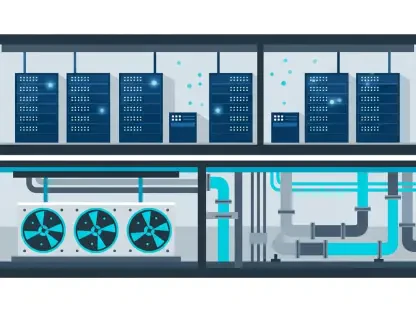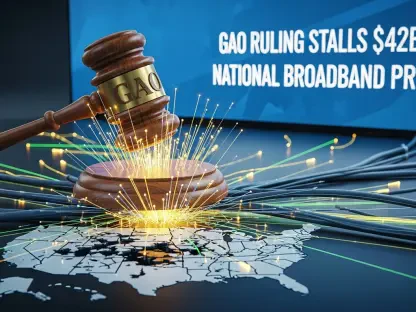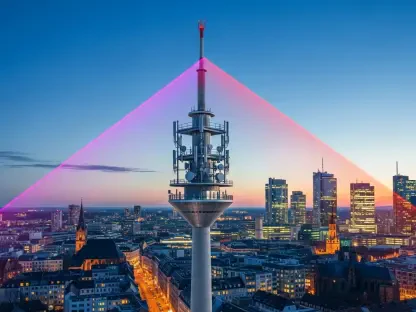In a telecom landscape battered by fluctuating investments and underwhelming 5G returns, Marvell Technology’s staggering 82% year-over-year revenue growth in its carrier infrastructure business stands as a striking signal of potential recovery, casting a hopeful light on the broader 5G ecosystem. This unexpected upswing, reported in the first half of the current year, not only highlights Marvell’s resilience but also offers optimism for key partners like Nokia. Amidst a market that has seen global radio access network (RAN) sales plummet in recent years, this rebound prompts a critical question: could this be the turning point for a sector yearning for stability? This market analysis delves into the trends, data, and projections surrounding Marvell’s resurgence, examining its implications for 5G technology and Nokia’s strategic positioning, while offering insights into the future of telecom investments.
Telecom’s Turbulent Terrain: Setting the Stage for Revival
The telecom industry has endured a rocky journey, with 5G deployments initially heralded as transformative but soon hampered by operator hesitance and financial constraints. Marvell, once a significant contributor to this space through its carrier infrastructure unit, saw its telecom revenue share shrink dramatically to less than 6% in recent times, reflecting a broader $10 billion drop in global RAN product sales over a short span. This decline mirrored struggles faced by Nokia, a major RAN equipment vendor, which lost substantial ground in key markets like North America. Yet, Marvell’s recent financial uptick suggests a possible shift in market sentiment, urging stakeholders to reassess the viability of sustained 5G investments.
This analysis aims to unpack the drivers behind Marvell’s recovery, focusing on its strategic partnerships and market positioning. By exploring current patterns and forecasting potential growth trajectories, the discussion seeks to provide clarity on whether this resurgence is a fleeting spike or a harbinger of long-term stabilization. With telecom cycles historically prone to dramatic swings, understanding these dynamics is crucial for operators, vendors, and investors navigating an uncertain landscape.
Deep Dive into Market Trends and Projections
Marvell’s Financial Turnaround: A Closer Look at the Numbers
Marvell’s carrier infrastructure business has staged an impressive comeback, posting revenues of $268.5 million in the first half of this year, a remarkable 82% increase compared to the prior period. This recovery contrasts sharply with the unit’s earlier decline, when sales plummeted by 68% to a low of $338 million. Analysts attribute this growth to a stabilizing demand for 5G components, particularly as operators begin to revisit network upgrades after a period of tightened budgets. The forecasted 30% sequential growth for the upcoming quarter further fuels optimism, suggesting that Marvell may be tapping into a renewed wave of telecom spending.
Beyond raw numbers, this financial rebound reflects a broader market willingness to re-engage with 5G technologies despite past disappointments. While Marvell’s telecom segment remains a smaller slice of its overall portfolio, its performance serves as a critical indicator of industry health. If sustained, this upward trend could encourage other suppliers to ramp up innovation and production, potentially accelerating the deployment of advanced network solutions across diverse regions.
Strategic Shifts: Balancing Telecom with Data Center Dominance
A pivotal aspect of Marvell’s current strategy lies in its pivot toward high-growth sectors like data centers and artificial intelligence (AI), which now account for 72% of total revenue with sales nearing $4.2 billion. This shift, driven by robust investor interest in AI-driven technologies, has somewhat overshadowed the telecom recovery, as evidenced by a 14% stock price drop despite positive carrier infrastructure results. The data center segment’s 88% sales surge underscores a pragmatic focus on areas promising faster returns, relegating telecom to a secondary role in corporate priorities.
However, this strategic reorientation poses challenges for maintaining momentum in carrier infrastructure. With investor attention fixated on AI, Marvell risks under-allocating resources to telecom innovations at a time when the market shows signs of revival. Balancing these competing priorities will be essential, especially as telecom’s cyclical nature suggests that periods of low investment often precede significant upswings, potentially offering substantial rewards for companies that remain committed.
Nokia Partnership: A Cornerstone for 5G Progress
Central to Marvell’s telecom resurgence is its deepened collaboration with Nokia, initiated several years ago to supply baseband chips for 5G basestations. This partnership has expanded over time, with Marvell displacing competitors in key areas like virtual RAN offerings, likely contributing significantly to the recent revenue spike. Nokia’s own recovery, marked by a reduced revenue decline of 6% this year and gains in contracts outside North America, indicates a symbiotic relationship that bolsters both entities’ standings in a competitive market.
Despite these positives, Marvell’s heavy reliance on Nokia introduces vulnerabilities, as its limited engagement with other major RAN vendors like Ericsson and Samsung restricts broader market penetration. Should Nokia face setbacks, Marvell’s telecom gains could falter, highlighting the need for diversified partnerships. Nevertheless, this alliance remains a linchpin for driving 5G advancements, particularly as virtual RAN architectures gain traction among operators seeking flexible network solutions.
RAN Market Dynamics: Challenges and Opportunities Ahead
The RAN market, valued at $35 billion recently, continues to grapple with the aftermath of a 22% sales drop over a short historical period, driven by operators’ reluctance to invest in 5G amid poor short-term returns. However, projections from industry analysts suggest low single-digit growth outside China in the near term, hinting at a potential bottoming out of the downturn. This cautious forecast aligns with observed upticks in operator confidence, spurred by emerging use cases such as industrial IoT that demand robust 5G connectivity.
Competitive pressures further complicate the landscape, with Nokia experiencing steeper declines compared to rivals like Ericsson, partly due to lost contracts with major operators. Marvell’s role as a key supplier to Nokia positions it favorably to capitalize on any market recovery, yet its minimal presence in other vendor ecosystems limits its exposure to broader growth opportunities. The push for supplier diversity among RAN vendors could reshape competitive dynamics, offering Marvell a chance to expand its footprint if strategic alignments are pursued effectively.
Future Outlook: Predicting 5G’s Next Phase
Looking ahead, several trends are poised to influence the telecom sector’s trajectory over the next few years, from 2025 to 2027. The cyclical pattern of telecom investments suggests that the current stabilization may prelude a significant upswing, especially as operators prioritize network modernization to support burgeoning digital demands. Technological advancements, including open RAN architectures, are expected to play a pivotal role, potentially enhancing Marvell’s relevance through its contributions to Nokia’s innovative offerings.
Economic recovery in key global markets could further catalyze operator spending, while regulatory developments around spectrum allocation and network security might shape investment priorities. Although Marvell’s telecom focus is likely to remain secondary to its data center pursuits, sustained growth in carrier infrastructure could solidify its position as a vital player in 5G’s evolution. These projections, while optimistic, hinge on the industry’s ability to address lingering monetization challenges and align technological capabilities with market needs.
Reflections and Strategic Pathways Forward
Reflecting on the analysis, Marvell’s telecom resurgence offers a critical lens through which to view the broader 5G market’s potential recovery, with Nokia emerging as a pivotal partner in this narrative. The financial uptick, alongside stabilizing RAN market indicators, underscores a moment of cautious hope for an industry that has weathered significant turbulence. These findings illuminate the interconnectedness of supplier-vendor relationships and the enduring impact of strategic pivots on market positioning.
Moving forward, stakeholders are encouraged to consider targeted investments in niche areas like virtual RAN, which show promise for driving innovation. Operators are advised to adopt phased 5G rollout strategies to balance costs with technological advancements, while vendors like Marvell could benefit from diversifying partnerships to mitigate risks tied to single-client dependencies. Monitoring global economic trends and regulatory shifts is deemed essential for anticipating the next investment cycle, ensuring that the telecom sector can capitalize on emerging opportunities and sustain momentum beyond the immediate recovery phase.









